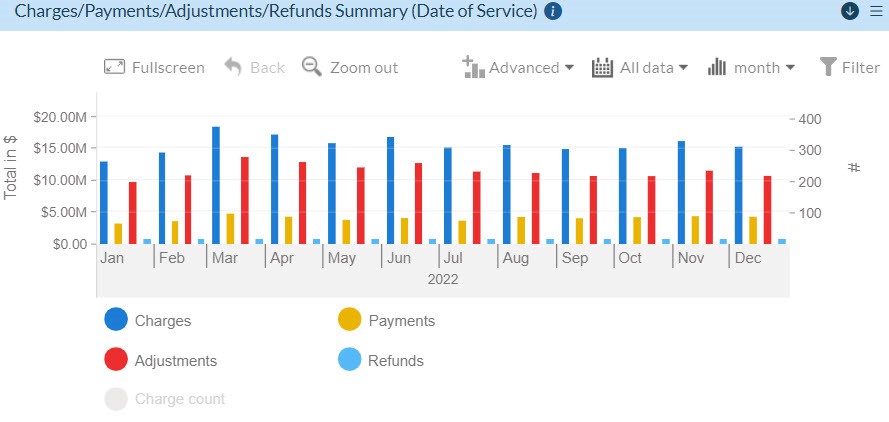
by Carrie Bauman
Maintaining a robust and efficient revenue cycle is crucial for the sustainability and growth of medical practices. As technological advancements continue to transform healthcare administration, the ability to harness comprehensive revenue cycle data has become pivotal. This blog will explain how practices can significantly enhance their revenue cycle efficiency by applying AI and ML equipped with predictive analytics to their own data. By transforming data patterns into actionable insights, practices can drive optimal financial health and ensure long-term viability.
A major challenge that healthcare practices face today is the potential for revenue leakage, often exacerbated by a lack of transparency to revenue cycle data. Revenue leakage can manifest in various ways:
MGMA highlights that practices without a robust revenue cycle analytics system may not detect these leaks until they have escalated into significant financial losses. By improving transparency and continually monitoring revenue cycle data, practices can proactively address these vulnerabilities, ensuring more secure and profitable operations
Effective management of billing volume is critical for maintaining revenue cycle efficiency. This includes monitoring the number of daily patient encounters and tracking days not final billed. Such data helps healthcare providers gauge their billing operations’ efficiency and identify periods of low activity or delays in billing that could negatively impact financial performance.
Claim rejections represent a significant source of revenue leakage. A detailed analysis of why claims are rejected—whether due to errors on the front-end, at the clearinghouse level or payer denials—is crucial. Such insights allow practices to refine their billing processes and enhance staff training, thereby reducing the likelihood of future rejections and accelerating the revenue collection process.
A thorough analysis of payments, including details about charges, payments, adjustments, and refunds, is crucial for understanding actual revenue inflow. This type of revenue cycle data provides practices with a clear depiction of their financial health, helping them to make informed decisions about operational and financial management.

Effective management of accounts receivable is vital for maintaining healthy cash flow. Metrics such as days in A/R, rolling A/R totals, and aging A/R by payer can help pinpoint issues in their collection processes, allowing for timely interventions to improve revenue recovery.


Performing a detailed analysis of payer performance can uncover disparities in claim submission and reimbursement patterns. This analysis helps practices negotiate better terms with payers and refine billing strategies to maximize revenue from all payer sources.
AI revenue cycle analytics revolutionize how practices approach revenue cycle management. By processing vast datasets quickly, AI can provide transparency to the health of your RCM workstreams, identify inefficiencies, predict trends, and provide recommendations for enhancing revenue cycle performance. This proactive approach ensures that practices can make informed decisions quickly, staying ahead of potential issues before they become problematic.
ML predictive analytics extend the capabilities of AI by not only analyzing current data but also predicting future trends and behaviors. This foresight allows practices to anticipate potential issues in their revenue cycle, such as likely denials or delays in payment, and to take preemptive action. Guided steps provided by ML algorithms can suggest specific interventions, streamlining the claims resolution processes, ensuring that practices remain financially healthy.
Leveraging advanced healthcare revenue cycle management AI equipped with predictive analytics is essential for healthcare practices aiming to optimize their financial operations in today’s competitive environment. Platforms like WhiteSpace Health’s revenue cycle module empower practices with deep insights into their revenue cycle data, enabling them to prevent revenue leaks, optimize billing processes, and ultimately enhance revenue cycle efficiency. In the realm of healthcare, where quality patient care and financial health are paramount, transforming complex data into actionable intelligence is the key to success. This strategic approach not only boosts financial performance but also improves patient care by reducing administrative burdens and enhancing service delivery.

A 30-year veteran in healthcare IT, Carrie Bauman is responsible for marketing, communications and business development strategies that drive brand awareness, growth and value for clients, partners, and investors.

2424 North Federal Highway, Suite 205
Boca Raton, FL 33431